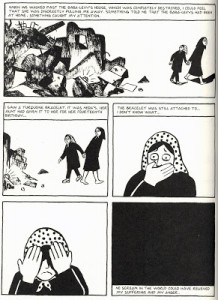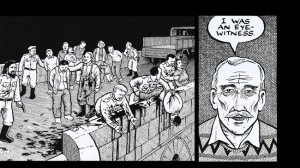Hi everyone!
For the past few classes, my ASTU 100 class has been reading another graphic narrative called “Safe Area Gorazde” by Joe Sacco. In this book Sacco details the safe town of Gorazde after the Bosnian War (1992-1995). After the war, Sacco, a journalist travels to Gorazde with many other journalists to document its citizens’ stories. However instead of being led around the town as if being in a tour at a zoo like the others, Sacco decides to stay with one of Gorazde’s inhabitants named Edin whom he soon befriends. In his many trips to Gorazde, Sacco unveils the different stories of the people of Gorazde as he befriends them; putting a human face to this conflict. These people are willing to share their stories with Sacco despite his position as an outsider to this event.
With Sacco being an outsider to the Bosnian War, I find that this is one of the major contrasts between this book and another book that we have read in my ASTU 100 class a couple of weeks ago. The other graphic narrative is called “Persepolis” by Marjane Satrapi. It details a young girl named Marji as she grows up in Iran during the Iranian Islamic Revolution and the Iran-Iraq War. However unlike Sacco taking up an outsider’s view in “Safe Area Gorazde”, Marji is an insider to the conflict. In “Persepolis”, the artwork is minimalistic, with the illustrations done simply and coloured with only black and white. This can be attributed with Marji’s (Satrapi’s portrayal of her younger self) seeing the conflict firsthand and the horror was too much and too complex to recapture as an image on the page as Satrapi drew the illustrations. However in Sacco’s case, he was an outsider to the conflict. His only way of knowing what happened in Gorazde during the war is through the interviews he had with its inhabitants. It is due to this that his illustrations are much more realistic and complex in contrast to Satrapi’s as he cannot really relate to the struggles of the inhabitants so he is able to draw their experiences in much more detail and complexity. Another contrast that can contribute to the different styles in portrayal can be of their ages when these incidents took place. Marji was a young girl when the Iran-Iraq War and the Islamic Revolution took place and her drawing style can be attributed to child-like simplicity while Sacco was a grown man when he made his way to Gorazde.
It is through these different styles that these two authors can portray their experiences with the readers, however I do wonder how do the readers grasp the different meanings and emotions behind the lines and shadings of the drawings? Are they able to understand the horrors Marji struggled through just by examining the simplistic lines? Or are they able to understand the true extent of the perils the people in Gorazde went through, through Sacco’s intricate drawings?

Marji finding her friend’s house having been destroyed and sees part of her body. The last frame shows Satrapi unable to draw her true emotions of the incident
Works Cited:
Sacco, Joe. Safe Area Gorazde. London: Fantagraphic Books, 2001. Print
Satrapi, Marjane Satrapi. Persepolis: The Story of a Childhood. New York: Random House, 2003. Print
Images:
